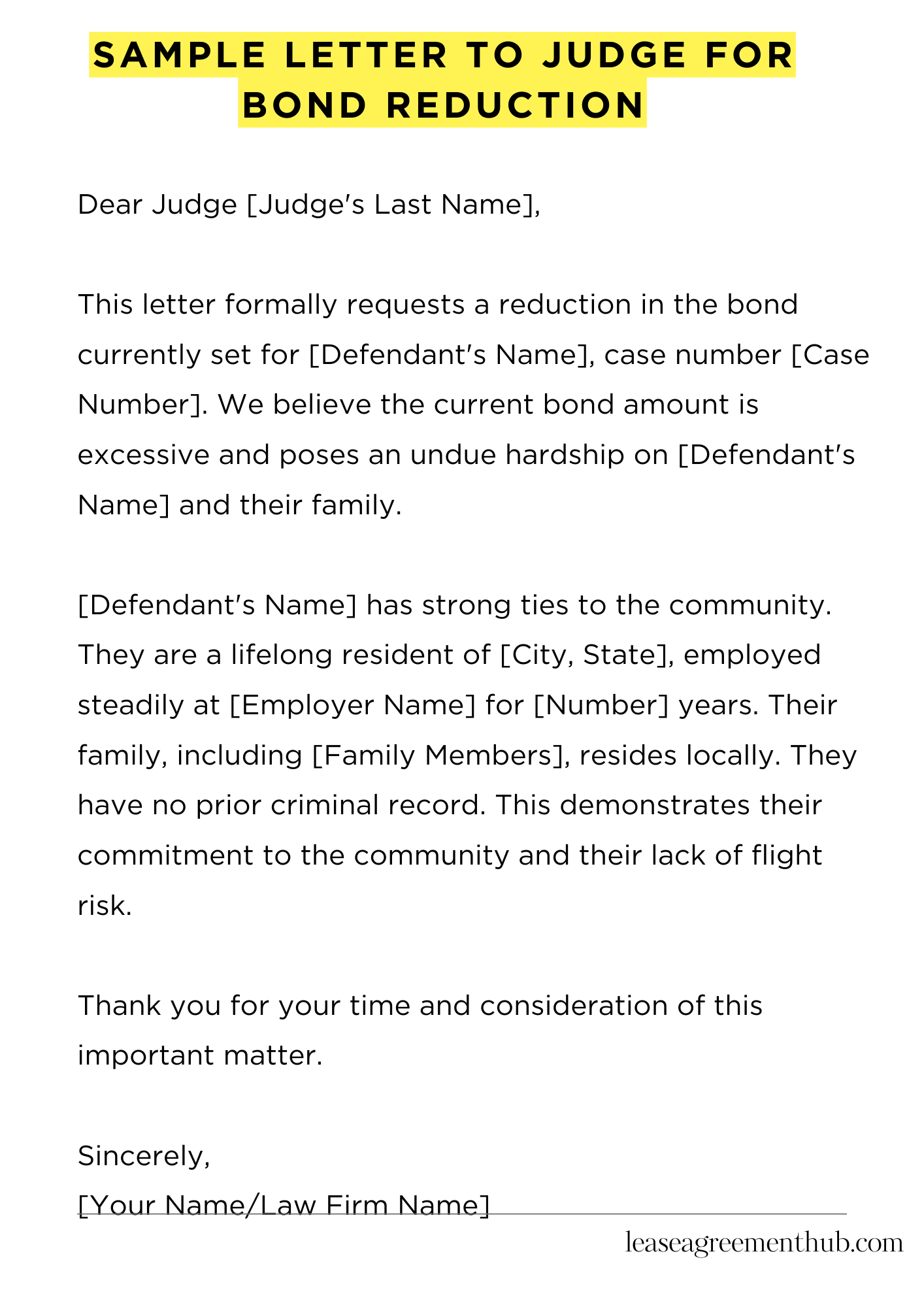Facing high bail? A bond reduction letter asks a judge to lower it. This lets you get out of jail sooner.
This article gives you examples. We provide templates and samples. Use them to write your own letter.
These examples make it simple. You can easily adapt them. Write a powerful letter. Get the bond lowered.
Sample Letter to Judge for Bond Reduction
The Honorable Judge [Judge’s Last Name]
[Court Address]
[City, State, Zip Code]
[Date]
Dear Judge [Judge’s Last Name],
This letter formally requests a reduction in the bond currently set for [Defendant’s Name], case number [Case Number]. We believe the current bond amount is excessive and poses an undue hardship on [Defendant’s Name] and their family.
[Defendant’s Name] has strong ties to the community. They are a lifelong resident of [City, State], employed steadily at [Employer Name] for [Number] years. Their family, including [Family Members], resides locally. They have no prior criminal record. This demonstrates their commitment to the community and their lack of flight risk.
The current bond amount prevents [Defendant’s Name] from maintaining employment and supporting their family. This financial strain could negatively impact their ability to prepare for their defense. A reduced bond would allow them to continue working and contributing to society. We are confident that a lower bond amount will ensure their appearance at all future court proceedings.
We propose a bond reduction to [Proposed Bond Amount]. We are prepared to offer [Supporting Evidence, e.g., property, surety bond]. This ensures [Defendant’s Name]’s continued presence in court. We believe this is a reasonable and appropriate modification.
Thank you for your time and consideration of this important matter. We look forward to your favorable response. We are available to discuss this further at your convenience.
Sincerely,
[Your Name/Law Firm Name]

How to Write a Sample Letter to Judge for Bond Reduction
Understanding the Gravity of the Situation
Before you even contemplate penning this crucial missive, understand its import. A request for bond reduction is not a mere formality; it’s a legal plea demanding meticulous crafting and irrefutable substantiation. Sloppy prose equals a summarily dismissed petition. Conciseness and clarity are paramount.
Structuring Your Argument: A Logical Framework
Your letter must follow a logical, persuasive trajectory. Begin with a succinct introduction stating your purpose unequivocally. Then, systematically present your arguments, each bolstered by concrete evidence. Avoid emotional appeals; rely instead on demonstrable facts and legal precedents. A well-structured argument is the cornerstone of a successful petition.
Compelling Evidence: The Foundation of Your Case
Evidence forms the bedrock of your appeal. This might include documentation of strong community ties, proof of stable employment, or evidence of any extenuating circumstances. Consider including character references attesting to your client’s probity. Each piece of evidence must be meticulously presented and directly supports your claim for a reduced bond.
Legal Precedents: Fortifying Your Position
Merely stating your desire for a bond reduction is insufficient. Your letter must demonstrate an understanding of relevant case law and legal principles. Cite relevant precedents, showing the judge that your request aligns with established legal norms. This legal acumen strengthens your argument considerably, implying a thorough understanding of the process and increasing the likelihood of a positive outcome.
Maintaining a Respectful Tone: Professionalism is Key
While advocating fiercely for your client, maintain a respectful and deferential tone throughout the letter. Avoid inflammatory language or any semblance of disrespect towards the court. Remember, your letter is a formal legal document; professionalism is non-negotiable. Maintain decorum throughout your argumentation.
The Art of Persuasion: Crafting a Cogent Narrative
Your letter isn’t just a document; it’s a narrative. Weave together the facts, evidence, and legal arguments to create a compelling case. Your ultimate objective is to persuade the judge that reducing the bond is in the best interests of justice. A well-crafted narrative can significantly sway the judge’s decision.
Proofreading and Revision: The Final Polish
Before submitting this crucial document, meticulously proofread and revise for any grammatical errors, typographical mistakes, or inconsistencies. A polished letter reflects your commitment to the process and showcases your seriousness. This final stage is often overlooked, but it significantly enhances your credibility and overall presentation.
FAQs about sample letter to judge for bond reduction
Seeking a bond reduction requires careful consideration and precise communication. A well-crafted letter to the judge is crucial for a successful outcome.
What information should be included in a letter requesting bond reduction?
A letter requesting bond reduction should include the defendant’s name and case number, a clear and concise statement requesting the reduction, the reasons for the request (e.g., strong ties to the community, employment stability, lack of flight risk), any mitigating circumstances, and a proposed new bond amount. It should also include contact information for the defendant and their attorney.
How formal should the tone of the letter be?
The tone should be highly formal and respectful. Avoid emotional language or arguments. Focus on presenting factual information and demonstrating the defendant’s suitability for a reduced bond. The letter should maintain a professional and persuasive tone throughout.
Should I include evidence to support my request?
Yes, providing supporting evidence strengthens your request significantly. Relevant documents such as employment verification, proof of address, family support letters, and any other documentation that demonstrates the defendant’s ties to the community and lack of flight risk should be included or referenced.
What if I don’t have an attorney? Can I write the letter myself?
While you can write the letter yourself, it’s strongly recommended to seek legal counsel. An attorney can ensure the letter is properly formatted, legally sound, and effectively presents your case. Improperly written letters can negatively impact your chances of success.
Where should I send the letter?
The letter should be sent to the appropriate court clerk’s office, or directly to the judge’s chambers, according to the specific instructions provided by the court. Always confirm the correct mailing address and follow any specific submission guidelines outlined by the court to ensure timely delivery and processing.
Related: